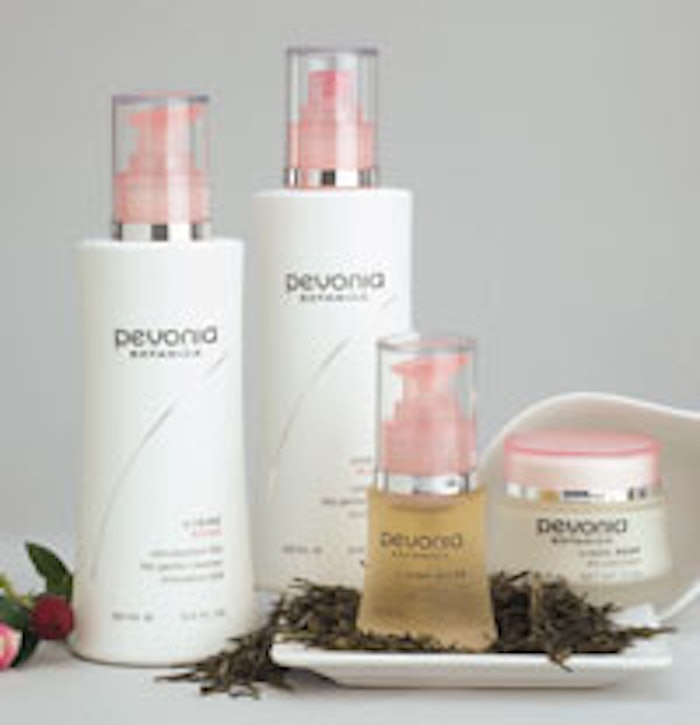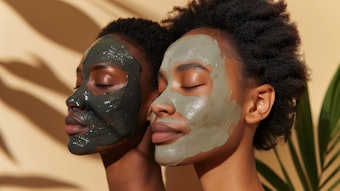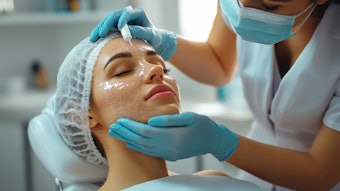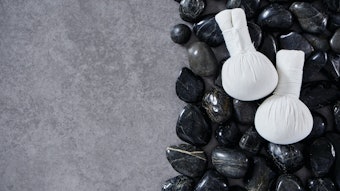
The National Rosacea Society has designated April as Rosacea Awareness Month to alert the public to the warning signs of this chronic and often progressive facial disorder, now estimated to affect more than 16 million Americans. As skin care professionals, you are in a unique position to educate and assist those suffering from this condition.
Get started now to prepare yourself and your spa's team to provide education and resources for rosacea-sufferers during the month of April. According to www.rosacea.org, a Gallup survey found that 78% of Americans have no knowledge of this condition, including how to recognize it and what to do about it.
Following are just a few examples of the steps that you can take to position your spa for success as rosacea resource.
- Train and educate staff to recognize the signs of rosacea, and make appropriate treatment and product recommendations. Your skin care supplier should be able to support you in this area. Pevonia partners enjoy on-demand webinars, step-by-step treatment DVDs and live seminars to help them develop the expertise to approach this condition successfully.
- Plan a rosacea awareness event. Offer free skin analysis, mini seminars, free literature and special offers on rosacea-focused treatments and services.
- Get involved with community events. Local health fairs, civic organizations and a multitude of other activities are available in most communities. Send a well-educated team member to offer rosacea information, answer questions, and hand out products samples and product/treatment discount coupons. Tracking how many special offers are redeemed and whether they are from new or existing clients is a great way to evaluate which community events are the best fit for your spa.
With more than 16 million Americans suffering from this condition, you can be assured that there are people in your community who are affected, and seeking your assistance and relief.
The definition of rosacea
Rosacea is a chronic skin disorder that is characterized by microcirculation problems that primarily affect the face, comprised of several symptoms that are related, such as couperose (dilation of facial blood vessels) and erythema (redness), to name a few. Extra-facial lesions on the neck and upper chest are not uncommon. The word "rosacea" comes from the Latin rosacea, derived from rosaceus meaning “pinklike.”
Although symptoms may occur during the teenage years, most clients experience the onset of rosacea in their 30s, 40s or 50s, occurring more predominately in fair-skinned women. The very precise cause of rosacea is still a discussion, but research has shown that many concomitant factors are involved such as genetic predisposition; heredity (especially European/Celtic descent); vascular anatomical disorders and dysfunctions; stomach dyspepsia and Helicobacter pylori infection; seborrhea; Demodex folliculorum mites; endocrine disorders; vitamin deficiency; liver disease; stress-related causes; and more.
Discerning the enigma
Rosacea clients are generally prone to “flushing and blushing,” mainly on the T-zone and cheeks. Flushing and blushing can occur either spontaneously or can be precipitated by certain triggers that play a particular role in the development of this skin disorder. These triggers include:
- Emotional stress;
- Heat and/or abrupt temperature changes;
- Caffeine;
- Sunlight and repeated sunburning;
- Alcoholic beverages;
- Spicy foods and foods that contain histamine or cause the body to release histamine, such as tomatoes and pineapple; and
- Medications, such as steroids, are known to augment these symptoms.
For example, a rosacea client may experience facial redness after drinking a hot beverage.One possible explanation would be that the heat from the beverage warms the blood irrigating the pharynx, which causes redirection of the blood flowing from the face to the brain, creating unwanted congestion at facial level.
According to scientific belief, blood vessels become damaged when they are repeatedly dilated by stimuli, in part mediated by the hypothalamus. It has been proposed that the local release of vasoactive substances has an important implication in this pathology causing inflammation, stagnation and congestion of blood. Associated factors include minor vascular anatomical disorders, and dysfunction of the “thermoregulatory vascular cooling system of the brain.” These factors are partly responsible for causing blood backflow to the face with increased vessel pressure that secondarily affects the sub-papillary venous plexus, leading ultimately to permanent vasodilation. Other very important factors that play a major role in damaging blood vessels include deterioration of the dermal matrix and the atrophy of supporting vessel tissues.
Also, pertaining to this disease and the role of microorganisms, greater numbers of Demodex folliculorum mites (part of the skin's normal flora inhabiting follicles) are found in some rosacea clients who exhibit papulo-pustular eruptions. One theory proposes that changes in connective and vascular tissue provide a favorable environment for the Demodex to multiply. Potentially, the mites can cause an immunologic reaction that triggers an inflammatory response. This contributes to the aggravation of the symptoms.
Furthermore, it has been suggested that H. pylori (an ulcer-related agent) synthesizes gastrin in the stomach, which has been linked to promoting flushing. The participation of microorganisms in the development of this disorder continues to remain unclear at this time. Further research is necessary.
Evolution of the disease
The evolution of rosacea affecting the skin usually progresses from a mild stage (redness and increased skin sensitivity) to a later stage (papulo-pustular eruptions, commonly known as acne rosacea). As the condition evolves, it may present complications, such as rhinophyma--nose enlargement, mostly a disfiguration affecting men; and rosacea fulminans--pyoderma faciale – abscesses and nodules. Fortunately, fulminans is a rare complication. Advanced and chronic schemes of the disease may additionally present sebaceous hyperplasias, fibrosis and lymphedema (swelling). Ocular rosacea may be accompanied by inflammation inside the eyes, lids and surrounding area. In some cases, recurrent conjunctivitis and periorbital lymphedema are reasons why clients consult their physicians.
The causative reasons for acne and acne rosacea are different. Acne originates primarily within the hair follicles as a result of a combination of factors that can lead to the production of lesions, which can be noninflammatory, inflammatory or both at the same time; very inflamed acne though, a stage III or IV, can certainly resemble some forms of rosacea, so confusing both is rather easy. On the other hand, rosacea is predominantly an inflammatory condition. Acne rosacea, identified by inflamed and raised lesions over an erythematous area, develops as papules and pustules that may foster parasitic microorganisms. Unlike common acne breakouts, the problem is not from bacteria, retention hyperkeratosis (dead cell retention) and excess sebum, but from a combination of parasitic activity and tissue inflammation. Clients may or may not report oiliness of the skin; sometimes they may actually experience drying and peeling. For skin care professionals, the most interesting and easily recognizable features of acne rosacea versus acne are the common absence of comedones and minimal scarring in acne rosacea, plus a logical correlation with the history of the condition when questioned during consultation with the individual.
Last but not least, there is also “neck rosacea,” which appears as a dilation of capillaries with diffused V-shaped reddish-brown discoloration on the sides of the neck, and gooseflesh appearance of the skin. This occurs due to repeated exposure to sunlight/sunburn on rosacea-prone skin causing partial atrophy of epidermis and dermis, but sparing the tissue surrounding the hair follicles, therefore creating a bumpy look and feel.
Treating rosacea
At the moment, there is no complete cure for rosacea, but it can be greatly improved with treatment and preventive measures to reduce symptoms. Early stages of the disease are characterized by minor cosmetic disabilities. Without proper attention, they can lead to severe disfigurement. The good news is that not everyone affected will develop every stage of the disease. It is imperative that control and action are taken to avoid further deterioration of both the condition and the client’s wellness.
Aside from avoiding its triggers, rosacea demands skin care. Proper treatment of the skin is vital to improve the symptoms and enhance quality of life. There are many courses to addressing rosacea from a medical standpoint, as well as from the esthetic/cosmetic approach.
Current medical treatments, for the most part, are effective in controlling symptoms associated with Demodex folliculorum mites, and the prevalence of redness and inflammation.
Doctors usually agree on treating rosacea by combining topical and systemic therapies. Some popular topical agents have proven somewhat effective in suppressing flares and producing a reduction in the parasitic infestation, including but not limited to, metronidazol and sulfacetamide. Widespread systemic agents include tetracyclins and minocycline. As with most prescription therapies, side effects may be unavoidable, especially if the drugs are utilized long term.
Laser and intense pulsed light (IPL) have shown remarkable results to improve facial flushing and erythema by targeting dilated blood vessel causing their atrophy and removal. LED light therapy has also proven somewhat beneficial for rosacea, especially when it comes to gentle healing and decrease of inflammation.
For the skin care professional in the field of esthetics, there are ready-to-use alternatives to help combat the disease and satisfy clients’ demands. However, if medical attention is needed, the skin care specialist should work with the physician to provide a complete wellness solution that will achieve maximum results for the concerned individual.
A natural and effective option
It is very important that skin care products for rosacea-affected individuals include ingredients capable of addressing microcirculatory and inflammatory problems. Pevonia’s RS2 Line features such ingredients in natural formulations:
- Green tea, with healing, anti-irritant, and anti-free radical properties;
- Licorice, with decongesting, anti-allergic and healing functions;
- Chamomile and French rose essential oils, well-known calming and soothing agents; and
- Allantoin with desensitizing benefits.
Pevonia offers a professional, high-performing globally renowned treatment known as the RS2 Rosacea Mask Treatment. Specially selected ingredients are layered over the skin and "sealed-in"at the end by means of an advanced lift-off bi-thermal mask. This therapy, as a whole, delivers calming and soothing active agents within the skin, while eliciting a healing, stimulating effect that mobilizes-–pumps away--blood from its stagnant pool, strengthening the capillaries’ endothelium and reducing erythema. This process progressively decreases frequent redness and comforts the skin. A series of treatments is recommended for the best outcome. The greatest features of this treatment are the progressive healing and recovering benefits, and the advantage that it can address rosacea at all levels, even combined with medical attention.
The RS2 line for home care, a must for those concerned, incorporates a complete regimen with RS2 Cleanser, RS2 Lotion, RS2 Concentrate (Serum) and RS2 Cream. These products contain the aforementioned ingredients to provide reparation, hydration, protection, control of blotchiness with reduction of redness, skin coolness and overall comfort with condition improvement. The formulations are designed to guarantee effective delivery of active agents and offer maximum results to ensure client satisfaction.
In addition, another viable topical option to address skin redness is camouflage makeup (preferably the mineral type). Makeup should be hypoallergenic, noncomedogenic, easy to apply, sweat-proof, and offer SPF protection. But even if makeup is not applied, conscious sun avoidance and a minimum SPF 30 sunscreen are highly recommended to preserve the skin’s well-being when staying outdoors for more than 15 minutes under broad sunlight.
You can learn more about Pevonia's RS2 Line and RS2 Rosacea Mask Treatment, along with other Pevonia products and treatments by visiting its website at www.pevoniapro.com. Also, learn more about becoming a Pevonia partner to access on-demand webinars, step-by-step treatment DVDs and live seminars to help develop the expertise to approach this condition--and others--successfully.
Disclaimer:
The above paid-for content was produced by and posted on behalf of the Sponsor. Content provided is generated solely by the Sponsor or its affiliates, and it is the Sponsor’s responsibility for the accuracy, completeness and validity of all information included. Skin Inc. takes steps to ensure that you will not confuse sponsored content with content produced by Skin Inc. and governed by its editorial policy.










